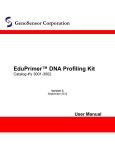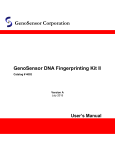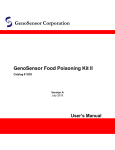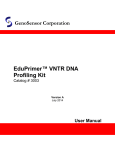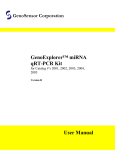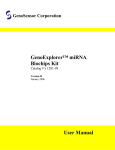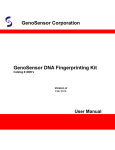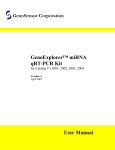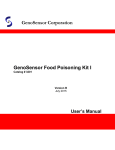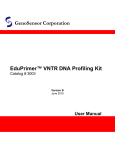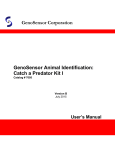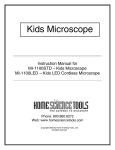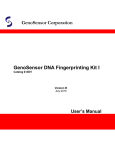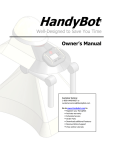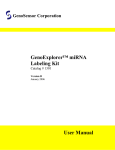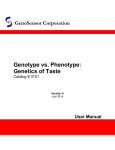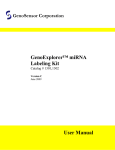Download Water Analysis - GenoSensor Corporation
Transcript
GenoSensor Corporation Water Analysis Catalog # 5001 Version A July 2014 User Manual Water Analysis Kit Manual Table of Contents Notes for Instructors ................................................................................ 2 Shipping, Storage and Safety .................................................................. 3 Water Analysis Kit Overview.................................................................... 4 Kit Components and Storage Conditions .................................................................................................. 4 Additional Required Materials .................................................................................................................. 4 Theory ....................................................................................................... 5 Water Analysis Kit Kit: Protocol .............................................................. 6 Preparation ............................................................................................................................................... 6 DNA Preparation ....................................................................................................................................... 6 PCR Reaction ............................................................................................................................................. 6 Agarose Gel Electrophoresis ..................................................................................................................... 7 Results and Discussion .............................................................................................................................. 9 Technical Background Information ....................................................... 10 Troubleshooting ..................................................................................... 14 Technical Service ................................................................................... 15 Literature Citation When describing a procedure for publication using these products, we would appreciate that you refer to them as the GenoSensor Water Analysis Kit. Water Analysis Kit - GenoSensor Corp. 1 Notes for Instructors Kit Components and Storage Conditions: Component 2X PCR Master Mix Positive Control DNA Negative Control (DNase- RNase-free H2O) DNA ladder Storage -20ºC -20ºC -20ºC -20ºC Preparation for DNA isolation and PCR Set heat block or water bath to 95ºC Instruct the students in cheek cell collection step to make sure proper technique and timing is used to ensure sufficient collection for DNA isolation. Thaw 2x PCR Master Mix on ice. Before opening tube, spin 10 sec at 6,000 rpm or greater in a microcentrifuge. Vortex 10 seconds, then spin again for 10 seconds. Aliquot the 2X PCR Master Mix as necessary after doing the above preparation. Each package contains enough PCR 2X Master Mix for 30 reactions. Use 10 ul of 2X PCR Master Mix with 10 ul template for a final PCR volume of 20 ul. Up to 3 positive control materials are available for PCR reactions (10 ul from Positive Control tube + 10 ul 2X PCR Master Mix for one reaction). Run 1 or up to 3 negative control reactions. Electrophoresis Electrophoresis reagents are not provided in the kit. Please refer to the required materials list. Best results are obtained by adding DNA dye (i.e. Gel Red or Sybr Safe) to molten agarose. Avoid exposing the agarose gel to light. It is best to store and run the gel in a dark room, or cover the gel with a box during gel polymerization and the whole electrophoresis process. There is enough DNA ladder to load 3 lanes with 10 ul. After PCR, load 10 ul of positive control reaction for up to 6 lanes. After PCR, load 10 ul of negative control reaction for up to 6 lanes. After PCR, load as much as 20 ul of student PCR reaction into a lane. Water Analysis Kit - GenoSensor Corp. 2 Shipping, Storage and Safety Shipping and Storage Water Analysis kits are shipped on blue ice. Components should be stored at temperatures shown in the above table. At proper storage conditions, components are stable for 1 year from the date received. Expiration dates are also noted on product labels. Safety Warnings and Precautions This product is intended for educational use only. It is not recommended or intended for the diagnosis of disease in humans or animals. Do not use internally or externally in humans or animals. Consider all chemicals as potentially hazardous. Only persons trained in laboratory techniques and familiar with the principles of good laboratory practice should handle these products. Wear suitable protective clothing such as laboratory overalls, safety glasses, and gloves. Exercise caution to avoid contact with skin or eyes: if contact should occur, wash immediately with water (Material Safety Data Sheet for products is available upon request). Water Analysis Kit - GenoSensor Corp. 3 Water Analysis Kit Overview What’s in your water? – The water we drink is put through large amounts of testing to make sure that it’s safe for us to drink. What are those tests, though, and what do they look for? The Water Analysis kit gives students the opportunity to test water samples from their own environment, and through PCR detect the presence of bacterial contaminates. Kit Components and Storage Conditions (for a lab of 24 students) Component 2X PCR Master Mix Positive Control DNA Negative Control DNA ladder Amount (30 rxn’s) 300 µL 30 µL 30 µL 30 µL Storage -20ºC -20ºC -20ºC -20ºC Additional Required Materials Thermal Cycler Heat Block or (heat plate, Beaker with de-ionized water; water bath, Tube floater; Thermometer) Microcentrifuge Microcentrifuge tubes Vortex Micropipettes (p10, p200, p1000) Pipette tips PCR tubes Tube Racks Ethanol or ethanol wipes Electrophoresis equipment Electrophoresis supplies: agarose, TBE, DNA loading buffer, running buffer, gel dye (eg. Sybr safe, Gel Red) Scissors and tweezers UV light box or “Gel Doc” equipment and program Water Analysis Kit - GenoSensor Corp. 4 Theory Is your water safe to drink? What are indicators that would make you think it is or isn’t? It's clear, it smells like water. Where did it come from? The source of your water is a good indicator of whether it’s safe to drink or not. We try not to drink unpurified water, but occasionally our water can become contaminated. Today we will be doing a water analysis that is commonly done in small communities. Based on the federal Safe Drinking Water Act (SDWA), all public water systems (PWS) must periodically check their water supply for possible breaks or leaks that can contaminate the water supply. Check your local drinking water system Every community has to submit an annual report called consumer confidence report. Check yours here http://water.epa.gov/drink/local/index.cfm It is not feasible to scan for all pathogens (pathogens are disease carrying organisms) instead we detect Coliforms. One regulation to the previously stated act is TCR "Total Coliform Rule" that enforces a Maximum Contaminant Level (MCL). Coliforms are not necessary harmful, they are an indicator organism. Their presence implies your water system might be compromised, which could be caused by a number of things. Coliform bacteria is a broad term for bacteria that are rod-shaped, Gram negative, non-spore forming and the ability to break down lactose. Escherichia coli is the hallmark example. E. coli co-evolved with mammals, evidence of this is the ability to break down lactose (the sugar in milk). All mammals produce milk for their young, at birth the baby acquires its gut flora from its mom. E. coli can be found in soil, on vegetation, and in the gut of warm blooded animals. It's an ecosystem we are indirectly part of. A rabbit eats plants with E. coli, the rabbit fertilizes the ground, plants grows on the feces, another rabbit eats the lettuce and the cycle continues and co-evolves. This experiment is primarily for educational purposes and thus is not meant to replace or challenge official water testing methods. If your drinking water is positive, consider notifying the water company but keep in mind bacteria are everywhere and could have contaminated your test results indirectly. Be careful to wear gloves and avoid letting the water sit too long exposed. Water Analysis Kit - GenoSensor Corp. 5 Water Analysis Kit Kit: Protocol Preparation 1. Set heat block or water bath to 95ºC. For a heat block, it is recommended to add water or sand to ensure proper heat transfer. For a water bath, be sure tubes are tightly sealed and not fully submerged to avoid contamination. 2. Thaw 2x PCR Master Mix on ice. Before opening tube, spin 10 sec at 6,000 rpm or greater in a microcentrifuge. Vortex 10 seconds, then spin again for 10 seconds. DNA Preparation Wear gloves and handle solutions carefully. Handle only your own sample 1. Pipette out 50 µl of your selected water sample into an appropriately labeled tube. If preparing the positive control, this step can be skipped. 2. Place the sample in the heat block or heat source to incubate at 95°C for 1 minute. The cells in the sample, should there be any, are damaged by this heating process. This exposes the DNA to make accessible to PCR components. PCR Reaction *Wear gloves and handle solutions carefully* 1. Prepare and label a small PCR tube with your name. Label both the top and side of the PCR tube to ensure clarity. 2. Ensure that the “2x PCR Master Mix” is on ice and has been spun at 6,000 RPM or greater in a microcentrifuge for 10 seconds, vortexed for 10 seconds, then spun again for 10 seconds before opening the Master Mix tube. 3. (as directed by instructor) Label and prepare PCR tubes for controls. Follow the table below 4. Add 10 µl of “2X PCR Master Mix” and 10 µl from your sample prepared above to the labeled PCR tube for a total of 20 µl as indicated in the table below. (Note: It is preferred that the PCR reaction mix preparation is done on ice). 5. Mix the 20 µl PCR reaction mixture by pipetting in and out with the pipette, and the close the lid tightly. 6. Store the sample on ice until it is ready to be loaded into the thermal cycler. PCR reaction mixture tables Student Sample PCR Mixture 2x PCR Master Mix 10 µl Prepared Water Sample 10 µl Volume total 20 µl Water Analysis Kit - GenoSensor Corp. 6 Control Samples PCR Mixture Positive Control 2x PCR Master Mix Negative control 10 µl 2x PCR Master Mix 10 µl Positive control DNA 10 µl Negative Control 10 µl Volume total 20 µl Volume total 20 µl Positive and negative controls give guidelines or boundaries to the experimental results. The positive control will show a result for water that is contaminated with E.coli and/or coliform bacteria. Negative control show the result if no DNA is present for the PCR. DNA ladder is a standard which is used like a ruler to show how DNA of a certain length will migrate through a gel during electrophoresis. PCR Parameters Program your thermal cycler as follows: 1. 2. 3. 4. 5. 94ºC – 2 minutes 94ºC denaturing – 20 seconds} 58ºC annealing – 20 seconds} repeat steps 2, 3, & 4 for 40 cycles 72ºC extension – 20 seconds} 72ºC – 5 minutes 6. 4ºC – finished / hold Agarose Gel Electrophoresis General Procedure, detailed directions as given by instructor Prepare 0.8 – 1% agarose. Set up electrophoresis apparatus and pour the 1% molten agarose for gelation. For staining, use a DNA dye which is added directly to the molten agarose. For light sensitive dyes, keep the gel in the dark during gelation, either by performing in a dark room or placing a box over the gel. Use at least 10 µL of PCR product to visualize results by electrophoresis on agarose gel. If gel well volume will accommodate more than 10 ul, a higher volume is preferred. Loading dye is added to the sample to ensure that the sample will sink to the bottom of the well and properly enter the agarose gel. Mix sample with loading dye according to instructor directions before carefully pipetting into a well in the gel. Be sure to record which well holds your sample. Water Analysis Kit - GenoSensor Corp. 7 Run at ~100V for ~20 minutes and stop before loading dye has run off gel. Depending on the DNA dye used, caution may need to be taken to reduce exposure of gel to light. Visualize under UV and record the results manually or by photography Compare individual experimental bands to positive control DNA. Example of Gel Setup and Loading: Run 3 gels with 12 wells each to accommodate 24 students and 6 control reactions. Lane 1: 10 µl DNA Ladder Lane 2: 10 µl Negative Control Lane 3: 10 µl Positive Control Lanes 4 -11 Up to 20 µl of each student sample Water Analysis Kit - GenoSensor Corp. 8 Results and Discussion What do the bands on the gel tell you? What does it mean if no bands are present for a sample? What purpose do the positive and negative control samples serve? Did they get the expected results? Fig 1. 10K DNA Ladder DNA Ladder reference for band size comparison Water Analysis Kit - GenoSensor Corp. What further steps might you take to verify your results? 9 Technical Background Information Introduction to PCR In 1983, during his time working at Cetus Corporation, Kary Mullis developed a technique that has changed the field of genetics and biological science in general. This revolutionary process was termed “polymerase chain reaction,” or PCR. He earned the Nobel Prize in Chemistry in 1993 due to his innovation. His technique enabled researchers, besides a few expert microbiologists, to amplify DNA. Before that, amplification of DNA was extremely difficult and time consuming. Now, scientists in any field can incorporate molecular biology into their research with PCR. Currently, PCR is used in a wide variety of areas, for example, gene mapping, DNA sequencing, gene expression, gene detection, forensics, criminal investigation, medical diagnostics, and genome sequencing. Very few of these applications were practically possible before PCR. The experiment does require an initial investment in specially made machinery, but with the proper equipment, nearly anyone can perform a successful PCR experiment without significant cost. PCR and Biotechnology — Revolutionizes an Entire Research Community PCR is capable of producing large amounts of targeted DNA from an extremely small amount of starting material, known as your template. DNA can be obtained from any cell such as blood cells, hair cells, cheek cells etc., and after proper treatment to isolate DNA, PCR can be applied to create millions of copies of virtually any desired DNA sequence. That is one of the most significant powers of PCR, specificity. Although you may put an entire genome worth of DNA into a PCR, it amplifies the exact piece of DNA desired and leaves the rest out. The basic components of PCR: - Reaction Buffer - DNA nucleotides (dNTP’s) of each adenine, guanine, thymine and cytosine - DNA polymerase - 2 DNA oligonucleotide primers - Template DNA (starting material) PCR Makes Use of Two Basic Processes in Molecular Genetics 1. Complementary DNA strand hybridization For DNA to be amplified, one must have a known sequence which flanks the gene of interest upstream and downstream. These sequences are used to create what are known as Water Analysis Kit - GenoSensor Corp. 10 ‘oligonucleotide primers,’ meaning a short ~20 base pair nucleotide sequence which is used as a starting point for DNA replication. The primers are said to be complementary to their target regions, so they will anneal (attach) to those regions specifically. Primers are required by DNA polymerase because it cannot add nucleotides without a preexisting chain. Complementary Strand Hybridization occurs when two different oligonucleotide primers anneal to each of their respective complementary base pair sequences on the template. They are designed specifically to anneal at opposite ends of opposite strands of the specific sequence of DNA that is desired to be amplified. 2. DNA strand synthesis via DNA polymerase In a PCR, a special type of DNA polymerase is used that is able to withstand the temperature fluctuations required for thermal cycling. Most DNA polymerases cannot tolerate the high temperatures and fluctuations from ~60ºC-94ºC. The breakthrough in PCR came with the isolation of DNA polymerase from a thermophilic bacterium known as Thermus aquaticus. This bacterial species lives in high temperature steam vents and therefore its DNA polymerase evolved to withstand extremely high temperatures. During PCR, DNA is synthesized and multiplies by 2 each cycle, thus the growth of DNA copy # over the reaction is exponential. In theory, after 30 cycles there will be 230. This is over a billion copies of DNA. Yielding this amount of DNA allows the possibility of visualization through a variety of means. One of the most popular visualization methods is agarose gel electrophoresis. PCR Stages The machinery required to perform PCR is known as a thermal cycler. The thermal cycler enables the steps of PCR to be automated. The reaction involves a repetitive series of cycles, each of which consists of template denaturation, primer annealing, and extension of the annealed primer by Taq DNA polymerase. Before beginning DNA amplification, genomic DNA is prepared from students' cells. The students’ DNA is then added to a mixture of the necessary reagents: oligonucleotide primers, thermostable DNA polymerase (Taq), the four deoxynucleotides (A, T, G, C), and reaction buffer. These reagents are pre-mixed as a 2X PCR Master Mix in the Water Analysis profiling kit. The tubes are placed into the thermal cycler. These thermal cyclers contain an aluminum block that holds the samples and can be rapidly heated and cooled across extreme temperature differences. The rapid heating and cooling of this thermal block is called temperature cycling or thermal cycling. The first step of the PCR temperature cycling procedure involves heating the sample to 94°C. At this high temperature, the template strands separate. This is called the denaturation step. The thermal cycler then rapidly cools to 60°C to allow the primers to anneal to the separated template strands. This is called the annealing step. The two original template strands Water Analysis Kit - GenoSensor Corp. 11 may reanneal to each other or compete with the primers for the primers complementary binding sites. However, the primers are added in excess such that the primers actually out-compete the original DNA strands for the primers’ complementary binding sites. Lastly, the thermal cycler heats the sample to 72°C for Taq DNA polymerase to extend the primers and make complete copies of each template DNA strand. This is called the extension step. Taq polymerase works most efficiently at this temperature. Two new copies of each complementary strand are created. There are now two sets of double-stranded DNA (dsDNA). These two sets of dsDNA can now be used for another cycle and subsequent strand synthesis. At this stage, a complete temperature cycle (thermal cycle) has been completed. Each step takes about 30 seconds to 1 minute, and this process continues for roughly 30-40 cycles depending on how the user has programmed the thermal cycler. Each step is repeated in that order each cycle until it is completed. At the end, the product is put on hold at a low temperature, generally 4°C, until the user is ready to proceed to the analysis of the product. Water Analysis Kit - GenoSensor Corp. 12 Figure 3. Experiment flowchart from start to finish Water Analysis Kit - GenoSensor Corp. 13 Troubleshooting Symptom Possible causes Solutions No amplification product Questionable template quality Analyze starting material Inhibitory Substance in reaction Decrease sample volume Insufficient cycle # Run additional cycle Incorrect thermal cycler program Verify times and temperatures Errors in heat block incubation Calibrate heating block, use sand or water to maximize contact with tube for proper heat transfer Autoclave tubes and use filter tips Lower annealing temperature in 2º increments Increase swabbing time, thoroughly swab. Contaminated tubes/solutions Weak bands/faint signal Primer annealing temperature too high Low concentration of DNA template DNA Dye degradation during preparation Expired, contaminated or degraded DNA dye Non-specific amplification product Premature Taq-polymerase replication Primer annealing temperature too low Insufficient mixing of reaction solution Exogenous DNA contamination Water Analysis Kit - GenoSensor Corp. Light sensitive dyes should be kept in the dark during gel preparation. Prepare in dark room or place a box over the electrophoresis apparatus during gelation and electrophoresis. Verify that the DNA dye has not degraded in storage, been contaminated or expired. Mix solutions on ice, place rxn directly to 94º thermal cycler Raise annealing temperature in 2º increments Mix solutions thoroughly before beginning the reaction -Wear gloves -Use dedicated area for sample preparation -Use non-aerosol tips 14 Technical Service For more information or technical assistance, please call, write, fax, or email. GenoSensor Corporation 4665 S. Ash Avenue Suite G-18 Tempe, Arizona 85282 Tel: 1-480-598-5378 Fax: 1-480-755-3319 Email: [email protected] Web: www.genosensorcorp.com Limited Warranty GenoSensor is committed to providing our customers with high-quality goods and services. Our goal is to ensure that every customer is 100% satisfied with our products and our service. If you should have any questions or concerns about a GenoSensor product or service, please contact our Technical Service at [email protected]. GenoSensor warrants that all of its products will perform according to the specifications stated on the certificate of analysis. This warranty limits GenoSensor Corporation’s liability only to the cost of the product. No warranty is granted for products beyond their listed expiration date. No warranty is applicable unless all product components are stored in accordance with instructions. GenoSensor reserves the right to select the method(s) used to analyze a product unless GenoSensor agrees to a specified method in writing prior to acceptance of the order. GenoSensor makes every effort to ensure the accuracy of its publications, but realizes that the occasional typographical or other error is inevitable. Therefore GenoSensor makes no warranty of any kind regarding the contents of any publications or documentation. If you discover an error in any of our publications, please report it to our Technical Service. GenoSensor assumes no responsibility or liability for any special, incidental, indirect or consequential loss or damage whatsoever. The above limited warranty is sole and exclusive. No other warranty is made, whether expressed or implied, including any warranty of merchantability or fitness for a particular purpose Water Analysis Kit - GenoSensor Corp. 15
















